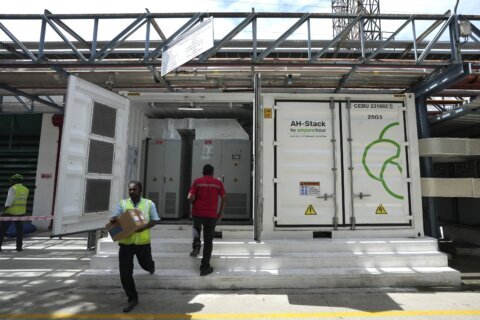Depending on your circumstances and possibly bad luck, you may be in need of all the government help you can get.
After all, while unemployment has been pretty low — 3.4% in April, according to the Bureau of Labor Statistics — if you’re part of that 3.4%, you’re out of a job and looking for work. Even if you are gainfully employed, you may be having trouble keeping your checking account from going into overdraft. Inflation hasn’t been as bad as it was a year ago, but prices are nonetheless 4.9% higher than 12 months ago, according to the BLS.
So if you’re feeling burned by the high cost of life, and you need help, you may want to consider asking the government for financial assistance, if you haven’t done so.
And if you feel any stigma involved with seeking out help, don’t, urges Sophie Raseman, head of financial solutions at Brightside, a financial care solution services company that works with employers to help employees reduce debt while improving emergency savings. In other words, Raseman’s entire job revolves around helping people who are strapped for money.
“If you’re on the fence about accessing government cash, please go for it,” Raseman says. “This is part of a larger system you’ve paid into over your lifetime. We’re all in this together, and you’ve worked hard. Curveballs like inflation are affecting us all.”
So with that pep talk in mind, read on for information on programs that essentially amount to free money from the government for things like paying for college, child care, rent and more. We’ll also offer up some tips on how to not get scammed — because con artists tend to pose as government agencies in an apparent effort to go after people who are stressed and distracted by their finances and theoretically more likely to be defrauded.
10 Ways to Get Free Money From the Government:
— Temporary Assistance for Needy Families.
— Supplemental Nutrition Assistance Program.
— Emergency Rental Assistance.
— Low-Income Home Energy Assistance.
— The Lifeline Program.
— Child Care and Development Fund.
— Down Payment Assistance.
— Pell Grant.
— Supplemental Security Income.
— Unclaimed.org.
Temporary Assistance for Needy Families (TANF)
Temporary Assistance for Needy Families is a major public assistance program that’s federally funded and run by the states. Also known as welfare, TANF may have a negative connotation for some, but the cash assistance it provides could be a financial lifesaver
for many people and their children.
How much you’ll receive depends on the state. In Oklahoma, according to Benefits.gov, the maximum amount an adult and two children can receive through TANF cash assistance is $292 per month. A family of three in Washington state, assuming they have no other income, would receive $654 a month.
You apply for TANF through your state’s administering agency, and to be eligible, you need to have a low income. States define that differently, but generally you must be really struggling financially.
Supplemental Nutrition Assistance Program (SNAP)
The Supplemental Nutrition Assistance Program is a safety net for low-income households. If you’re eligible for SNAP benefits, previously known as food stamps, your state will issue you an electronic benefits transfer card, which works like a debit card. You can use the EBT card at authorized stores to buy certain foods for your household.
To be eligible for SNAP, your household must meet net and gross income limits based on a household’s size. For instance, according to the Center on Budget and Policy Priorities, a household of three (one adult and two kids) would receive $577 a month.
[READ: How to Save Money When Grocery Shopping on a Budget]
The U.S. Department of the Treasury’s Emergency Rental Assistance (ERA)
If you’re unable to pay your rent or utilities and believe you’re in danger of eviction, the U.S. Treasury’s Emergency Rental Assistance program may be able to help. This program began early in the pandemic and is no longer available everywhere but is still operating in many states.
You may be able to get help with rent for multiple months rather than just receiving enough money for one month’s rent. To find emergency rental assistance options in your area, go to the Consumer Financial Protection Bureau’s website or the U.S. Treasury website.
Low Income Home Energy Assistance Program (LIHEAP)
If you’re struggling to pay your heating or cooling costs, this program could help — and it doesn’t matter whether you’re a homeowner or a renter. The Department of Health and Human Services oversees the Low Income Home Energy Assistance Program, or LIHEAP, although each state decides whether a household is eligible for a cash grant. But anyone who is already enrolled in a program like SNAP has a chance of being automatically eligible, according to Benefits.gov.
Grants, which tend to be based on income, how many people live in the home and the type of fuel used to heat or cool the home, generally, in the last few years, have ranged from $500 to $1,500 and are paid directly to the utility.
“Unlike SNAP, LIHEAP funds are first come, (first served), so act quickly,” Raseman says. “Google your state’s LIHEAP program to find if it’s currently accepting applications.”
The Lifeline Program
This program provides a discount on phone or internet service for qualifying low-income consumers. The Lifeline program is available in every state, territory and commonwealth and on tribal lands, and it can cover home or mobile phone service or high-speed broadband. To qualify, consumers must have a gross household income at or below 135% of the federal poverty guidelines or participate in SNAP, Medicaid or other federal programs.
If eligible, you may receive $9.25 per month toward phone or internet services. This won’t likely cover your entire phone or internet bill, but it could help offset the high cost.
[10 Ways to Save Energy and Lower Utility Bills]
Child Care and Development Fund
The Child Care and Development Fund is designed for low-income families who need assistance paying for child care due to work, school or training related to work.
How low must your income be to qualify? It’s impossible to say, since every state makes that determination. If you consider yourself middle income, you may think you make too much money, but don’t make that assumption. See the eligibility checker on Benefits.gov to find out if you’re a candidate for this benefit.
According to the National Association of Counties, in 2018, the last year data was available, only 14% of eligible children participated in the CCDF.
Down Payment Assistance Programs
If homeownership seems almost financially in reach if only you had a helping hand, look into first-time homebuyer programs that offer down-payment assistance. (Programs also exist to help repeat homebuyers.) You may find a program that offers a grant for a down payment (free money) or a zero-interest forgivable loan (also free money) or a low-interest loan (cheap money). There are also programs that offer help with closing costs.
Check with your city or county’s government office to find out about programs offering down-payment assistance. The U.S. Department of Housing and Urban Development’s website also has a lot of information on state and local government first-time home buying and down-payment assistance programs.
Pell Grant
If you have a child going to college soon, have your child apply for the Pell Grant, which they can do by completing the Free Application for Federal Student Aid, or FAFSA, at Fafsa.gov. It can be a little overwhelming, but the financial aid virtual assistant can help. So can the Federal Student Aid Information Center, which is staffed with people who can answer questions. If eligible for the federal Pell Grant, your child could get up to $7,395 for the 2023-24 school year — money that doesn’t have to be paid back.
Supplemental Security Income (SSI)
This federal program helps disabled adults and kids who have low income and few resources. The Social Security Administration runs the program, but the money beneficiaries receive isn’t funded with Social Security taxes. According to the SSA, the monthly maximum an eligible individual could receive in 2023 is $914. An eligible individual with an eligible spouse could receive $1,371. An essential person — someone who lives in the home and takes care of the eligible individual — could receive $458.
[Read: The Future of Social Security.]
Unclaimed.org
In this case, the government is helping you — for free — get your own money back.
Unclaimed.org is run by the National Association of Unclaimed Property Administrators, or NAUPA, which is a network within the National Association of State Treasurers. If you have lost or unclaimed money — whether it’s tens of thousands of dollars in unclaimed life insurance benefits or $11.50 that you didn’t realize was in an abandoned checking account — you may find it here. It may seem too good to be true, but this is a legitimate way to put some money back in your bank account.
MissingMoney.com, endorsed by NAUPA, is also worth checking out. According to NAUPA, states are holding onto unclaimed money and assets of 1 out of every 10 Americans and return over $3 billion a year.
How to Avoid Scams
Government agencies, by design, exist to help the public. The people pretending to be government agency officials, however, are not here to do that. They want to bleed you dry.
How to tell the good guys from the bad guys? A few tips:
Don’t believe everything you hear. Mostly, you can solve a lot of problems if you “always double-check the program’s legitimacy,” says Adnan Mahmud, CEO of FORWARD Platform, a program administration solution provider for local and state governments.
“Visit the official government website or contact the relevant agency to confirm it’s real,” Mahmud says.
So if you are contacted by a government official (and as a general rule, government agencies don’t contact members of the public out of the blue, unless there is a pre-existing relationship), before you give out any personal information, follow Mahmud’s advice and go to your favorite search engine and look up everything you can about the agency.
Don’t send money. “Be cautious of unknown programs making unrealistic promises or asking for upfront payments,” Mahmud says. No kidding. Except for the Internal Revenue Service and a few other exceptions, such as paying fees for a passport, you’re generally never going to be sending any government agency money.
Submit information through the official, secure application portal. “Use official channels and documentation provided by the government. Avoid unofficial websites or platforms for submitting personal information,” Mahmud says. “If submitting applications online, look for secure protocols, such as HTTPS, to ensure your data is protected.”
If you look at the URL on this article, for instance, you’ll notice it has the words “https.” The “s” stands for “secure.” If you notice you’re giving information to a site that reads, “http,” stop what you’re doing.
There is a lot of free money from the government designated to help people in need. If you need it, you shouldn’t feel bad about asking for it. It’s just that the government rarely, if ever, is going to seek you out and offer to give it to you. If you get a surprise text, email or phone call from the government offering free money, your alarm bells should go off. That person is probably looking to get free money — from you.
More from U.S. News
13 Companies That Offer Unlimited Vacation Days
The Fastest Growing Jobs in America
10 Ways to Get Free Money From the Government originally appeared on usnews.com
Update 05/31/23: This story was published at an earlier date and has been updated with new information.







